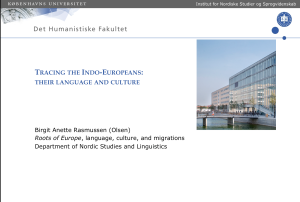Abstract
Languages of the Indo-European language family are spoken by more than half of the world’s population, from Iceland in the west to India in the east. On linguistic grounds it is possible to reconstruct parts of their ancestral language with respect to phonology, morphology and lexicon, but who were the people who spoke this language? Where did they come from, when did they spread from their original homeland, and what was their culture like? In recent years historical-comparative linguists, archaeologists and geneticists have worked together in an attempt to solve the puzzle by finding an internally coherent scenario. The lecture will present some highlights from this work in progress.

Mini-bio
As an Indo-Europeanist, my field of research embraces the Indo-European language family as a whole, including the interface between language and culture in terms of “Wörter und Sachen”, poetics, comparative mythology and the archaeological basis for an identification of the Indo-European homeland in time and space. These latter aspects have played a crucial role in the interdisciplinary project Roots of Europe – language, culture, and migration (2008-13), and much of my most recent work has been dealing with the common Indo-European lexicon and its significance for the reconstruction of Indo-European material culture. My special field of interest of a purely linguistic nature is nominal word formation, in the protolanguage as well as specific branches such as Indo-Iranian, Greek, Latin, Germanic and in particular Armenian.